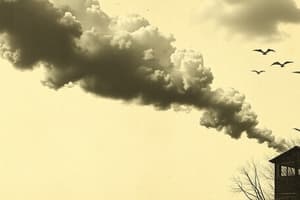Podcast
Questions and Answers
Which of the following best describes the relationship between air temperature and air density?
Which of the following best describes the relationship between air temperature and air density?
- As air temperature decreases, air density decreases because particles move faster and spread out.
- As air temperature increases, air density decreases due to the increased separation of air particles. (correct)
- Air temperature and air density are not related.
- As air temperature increases, air density increases due to the higher kinetic energy of the particles.
How does humidity affect atmospheric pressure, and what is the underlying reason for this effect?
How does humidity affect atmospheric pressure, and what is the underlying reason for this effect?
- Higher humidity increases air pressure due to increased molecular collisions.
- Higher humidity decreases air pressure because water molecules are lighter than nitrogen and oxygen molecules. (correct)
- Humidity has no effect on air pressure.
- Higher humidity increases air pressure because water molecules are heavier than nitrogen and oxygen molecules.
Why do mountain climbers often need to carry oxygen tanks when ascending high peaks?
Why do mountain climbers often need to carry oxygen tanks when ascending high peaks?
- The air is more humid at higher elevations.
- The air is less dense at higher elevations, resulting in lower atmospheric pressure and less oxygen per volume. (correct)
- The air is significantly warmer at higher elevations.
- There is more pollution at higher altitudes requiring supplemental oxygen.
Consider two locations, one at sea level and the other on a high plateau. Assuming all other conditions are equal, what difference in atmospheric pressure would you expect to observe?
Consider two locations, one at sea level and the other on a high plateau. Assuming all other conditions are equal, what difference in atmospheric pressure would you expect to observe?
Which of the following scenarios would most likely lead to the formation of wind?
Which of the following scenarios would most likely lead to the formation of wind?
What is the relationship between air temperature, particle density, and air pressure as described in the text?
What is the relationship between air temperature, particle density, and air pressure as described in the text?
Consider a scenario where sunlight heats a coastal area, warming the land more quickly than the adjacent sea. Based on the principles of convection currents, which of the following describes the expected air movement?
Consider a scenario where sunlight heats a coastal area, warming the land more quickly than the adjacent sea. Based on the principles of convection currents, which of the following describes the expected air movement?
Two barometers are positioned 25 kilometers apart. Barometer X reads 1030 hPa, and Barometer Y reads 980 hPa. Calculate the pressure gradient force between these two locations.
Two barometers are positioned 25 kilometers apart. Barometer X reads 1030 hPa, and Barometer Y reads 980 hPa. Calculate the pressure gradient force between these two locations.
Which of the following conditions would MOST likely result in a strong pressure gradient force and consequently strong winds?
Which of the following conditions would MOST likely result in a strong pressure gradient force and consequently strong winds?
In the Northern Hemisphere, if air is moving towards a low-pressure center, in which direction will it be deflected due to the Coriolis Effect, and what type of spiral pattern will it form?
In the Northern Hemisphere, if air is moving towards a low-pressure center, in which direction will it be deflected due to the Coriolis Effect, and what type of spiral pattern will it form?
Flashcards
Air Composition
Air Composition
Air is filled with particles in constant motion, colliding and releasing heat.
Air Expansion
Air Expansion
Air expands, particles move further apart, fewer collisions occur, and heat decreases.
Wind
Wind
Air movement caused by pressure differences, moving from high to low pressure areas.
Atmospheric Pressure
Atmospheric Pressure
Signup and view all the flashcards
Elevation and Pressure
Elevation and Pressure
Signup and view all the flashcards
Convection Current
Convection Current
Signup and view all the flashcards
Pressure Gradient Force
Pressure Gradient Force
Signup and view all the flashcards
Barometer
Barometer
Signup and view all the flashcards
Coriolis Effect
Coriolis Effect
Signup and view all the flashcards
Pressure Systems
Pressure Systems
Signup and view all the flashcards
Study Notes
- Air contains atoms and molecules like nitrogen, oxygen, and carbon dioxide, which are in constant motion.
- These particles collide, releasing heat; more energy leads to faster motion and more heat.
- Energized air expands, which reduces collisions.
- Air cools as it expands.
Wind
- Wind is air in motion.
- It is a force that can both destroy and create.
- Understanding wind causes is important for forecasting storms and planning infrastructure.
Causes of Wind
- Pressure differences cause air movement.
- Atmospheric pressure refers to the weight of air pushing down on Earth.
Factors Affecting Pressure
- Elevation, humidity, and temperature cause changes in pressure.
- Higher elevation equates to lower pressure, due to fewer air molecules.
- Lower pressure occurs at higher elevations, due to fewer air molecules.
- Water vapor is lighter than air, so, higher humidity means lower air pressure.
- Energized air expands and rises, leading to lower pressure.
- Cool, heavy air descends, creating high pressure.
- The sun's uneven heating creates high and low-pressure systems.
- Air moves from high to low-pressure systems, producing wind.
Convection Currents
- Convection is the heat transfer via air or liquid; warm air rises, cools, and falls.
- As warm air rises, it displaces cooler air laterally, creating a cyclical current.
- An example, the sun heats a black road, warming the air above it, resulting in cooler air from surroundings being drawn in.
Pressure Gradient Force
- Uneven surface heating causes pressure differences, creating high and low-pressure systems.
- Wind strength relies on the pressure difference between systems.
- Pressure gradient force relies on pressure and distance between systems.
- Greater pressure difference and closer proximity increase wind strength.
- Atmospheric pressure is measured using a barometer in pascals (Pa), with hectopascals (hPa) used for easier reading.
- One atmosphere (air pressure at sea level at 15°C) is 1,013 hPa.
- Pressure gradient force equals the pressure difference divided by distance.
- Measuring pressure gradient force is a key component of meteorology and weather forecasting.
- Strong pressure gradient forces signal severe storms.
- Hurricanes and tornadoes are areas of extremely low pressure, leading to strong gradient forces.
Coriolis Effect
- Earth's rotation impacts air currents.
- The equator receives the most sunlight and it becomes a low-pressure area.
- The poles receive weak sunlight, which makes them high-pressure areas.
- Air moves from the poles to the equator (high to low pressure).
- Wind currents in the Northern Hemisphere move counterclockwise from the North Pole to the equator, however, the Southern Hemisphere moves clockwise from the South Pole to the equator.
- The Coriolis Effect acts perpendicular to the pressure gradient force, shaping weather patterns such as hurricanes.
- The Coriolis Effect is due to varying rotation speeds at different latitudes: points near the equator rotate faster than those near the poles.
- An object thrown from the equator drifts east, while one thrown from the North Pole drifts west, due to these speed differences.
- The Northern and Southern Hemispheres have three convection cells: Hadley, Ferrel, and Polar.
- The Hadley Cell creates Trade Winds in the tropics.
- Jupiter's cloud bands demonstrate atmospheric cells created by the Coriolis Effect and convection.
Friction
- The Earth's surface impacts wind patterns.
- Structures like mountains and buildings create friction, slowing wind and changing its direction.
- Friction reduces the Coriolis Effect and strengthens the pressure gradient force.
- Friction's effects are most evident near the Earth's surface.
Studying That Suits You
Use AI to generate personalized quizzes and flashcards to suit your learning preferences.




